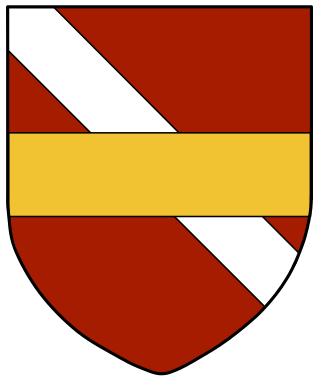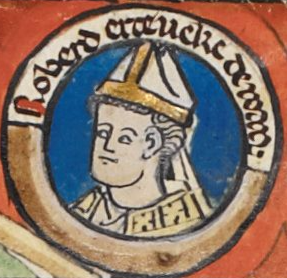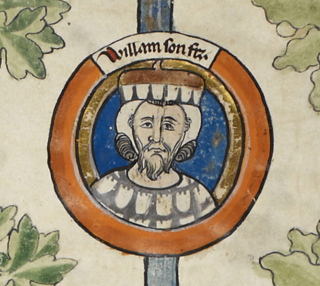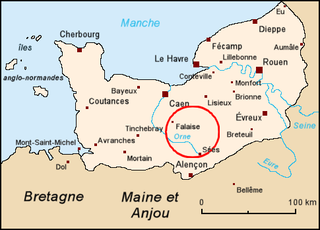Related Research Articles

Robert I of Normandy, also known as Robert the Magnificent and by other names, was a Norman noble of the House of Normandy who ruled as duke of Normandy from 1027 until his death in 1035. He was the son of Duke Richard II; the brother of Duke Richard III, against whom he unsuccessfully revolted; and the father of Duke William who became the first Norman king of England after winning the Battle of Hastings in 1066. During his reign, Robert quarrelled with the church—including his uncle Robert, archbishop of Rouen—and meddled in the disorder in Flanders. He finally reconciled with his uncle and the church, restoring some property and undertaking a pilgrimage to Jerusalem, during which he died.

William FitzOsbern, 1st Earl of Hereford, Lord of Breteuil, was a relative and close counsellor of William the Conqueror and one of the great magnates of early Norman England. FitzOsbern was created Earl of Hereford in 1067, one of the first peerage titles in the English peerage. He is one of the very few proven companions of William the Conqueror known to have fought at the Battle of Hastings in 1066. His chief residence was Carisbrooke Castle on the Isle of Wight, one of many castles he built in England.

Richard II, called the Good, was the duke of Normandy from 996 until 1026.
Alan III of Rennes was Count of Rennes and duke of Brittany, by right of succession from 1008 to his death.
David Bates is a historian of Britain and France during the period from the tenth to the thirteenth centuries. He has written many books and articles during his career, including Normandy before 1066 (1982), Regesta Regum Anglo-Normannorum: The Acta of William I, 1066–1087 (1998), The Normans and Empire (2013), William the Conqueror (2016) in the Yale English Monarchs series and La Tapisserie de Bayeux (2019).

Richard I, also known as Richard the Fearless, was the count of Rouen from 942 to 996. Dudo of Saint-Quentin, whom Richard commissioned to write the "De moribus et actis primorum Normanniae ducum", called him a dux. However, this use of the word may have been in the context of Richard's renowned leadership in war, and not as a reference to a title of nobility. Richard either introduced feudalism into Normandy or he greatly expanded it. By the end of his reign, the most important Norman landholders held their lands in feudal tenure.

The House of Normandie designates the noble family which originates from the Duchy of Normandy and whose members were dukes of Normandy, counts of Rouen, as well as kings of England following the Norman conquest of England. It lasted until Stephen of the French House of Blois seized the English throne and the Duchy of Normandy in 1135. The house emerged from the union between the Viking Rollo and Poppa of Bayeux, a West Frankish noblewoman. William the Conqueror and his heirs down through 1135 were members of this dynasty while nearly every English monarch since William have been his descendant.

Robert II, Archbishop of Rouen, and Count of Évreux was a powerful and influential prelate, and a family member of and supporter of five dukes of Normandy.

William of Jumièges was a contemporary of the events of 1066, and one of the earliest writers on the subject of the Norman conquest of England. He is himself a shadowy figure, only known by his dedicatory letter to William the Conqueror as a monk of Jumièges. Since he also mentions that he was an eyewitness of some events from the reign of Duke Richard III (1026-7), it seems reasonable to assume that he was born some time about the year 1000. He probably entered the monastery during the first quarter of the eleventh century and received his education from Thierry de Mathonville. According to Orderic Vitalis, William's nickname was "Calculus". The meaning behind this nickname is unknown. His death, after 1070, is unrecorded. He was a Norman writing from a Norman point of view. Although only a monk with evidently no military training, he wrote with pride in the accomplishments of his people.

William Longsword was the second ruler of Normandy, from 927 until his assassination in 942.
Robert de Grantmesnil also known as Robert II, was a Norman nobleman; a member of a prominent Norman family. He first became a monk, then abbot at the Abbey of Saint-Evroul in Normandy and later Bishop of Troina in the Norman Kingdom of Sicily.
Humphrey de Vieilles was the first holder of the "grand honneur" of Beaumont-le-Roger, one of the most important groups of domains in eastern Normandy and the founder of the House of Beaumont. He was married to Albreda or Alberée de la Haye Auberie.
John of Avranches was bishop of Avranches from 1060 to 1067, and archbishop of Rouen from 1067 to 1079. He was a Norman churchman, son of Rodulf of Ivry, and brother of Hugh of Bayeux. He appears in the Gesta Normannorum Ducum of William of Jumièges, and may have been one of the sources William used.
Osbern the Steward, known in French as Osbern de Crépon, was the Steward of two Dukes of Normandy and the father of William FitzOsbern, 1st Earl of Hereford, one of William the Conqueror's closest counsellors.

Gisela was a French princess who was married to Rollo, Duke of Normandy. It is uncertain whether Gisela existed.
Sprota was an early 10th century woman of obscure origin who became wife 'in the Viking fashion' of William I, Duke of Normandy, by her becoming mother of his successor, Duke Richard I. After the death of William, she married a wealthy landowner, Esperleng, by him having another son, Norman nobleman Rodulf of Ivry.
Ralph of Gacé, also known as Ralph the Ass-Headed, was a member of the House of Normandy who played an influential role during the minority of William the Bastard, prior to his conquest of England. Ralph was the lord of Gacé and other estates in Normandy.

Roger de Montgomery, was seigneur of Montgomery, vicomte of the Hiémois, and a member of the House of Montgomery.

The Château d'Ivry-la-Bataille is a ruinous Norman castle in the town of Ivry-la-Bataille in the Normandy region. It is among the earliest examples of a stone donjon or keep, which would become a common feature of later Norman castles in various parts of Europe.
Hugh of Ivry or Hugh of Bayeux was bishop of Bayeux and count of Ivry from the beginning of the 11th century.
References
- ↑ Eleanor Searle, Predatory Kinship and the Creation of Norman Power, 840-1066 (University of California Press, Berkeley, 1988), p. 292 n. 8
- ↑ Francois Neveux. A Brief History of The Normans (Constable and Robinson, London, 2008), p. 74
- 1 2 Eleanor Searle, Predatory Kinship and the Creation of Norman Power, 840-1066 (University of California Press, Berkeley, 1988), p. 108
- ↑ The Normans in Europe, ed. & trans. Elisabeth van Houts (Manchester University Press, 2000), p. 57
- ↑ François Neveux, La Normandie des ducs aux rois, Ouest-France, Rennes, 1998, p.65
- ↑ Guillaume de Jumièges, Histoire des ducs de Normandie, éd. Guizot, 1826, interpolating Robert de Torigni and Ordericus Vitalis, p.111-114
- ↑ David C. Douglas, 'The Earliest Norman Counts', The English Historical Review, Vol. 61, No. 240 (May, 1946), p. 131
- ↑ David Bates, Normandy before 1066, p.114
- ↑ Pierre Bauduin, La première Normandie (Xeme-XIeme siècles), Presses Universitaires de Caen, 2004, p. 200
- ↑ Pitte, Dominique (2000). Le Château d'Ivry (Eure)- La Normandie vers l'an mil. Rouen: société de l'histoire normande.
- ↑ Gazeau, Véronique. Le patrimoine d'Hugues de Bayeux (c. 1011-1049). pp. 139–147.
- 1 2 3 4 5 6 Detlev Schwennicke, Europäische Stammtafeln: Stammtafeln zur Geschichte der Europäischen Staaten , Neue folge, Band III Teilband 4, Das Feudale Frankreich und Sien Einfluss auf des Mittelalters (Marburg, Germany: Verlag von J. A. Stargardt, 1989) Tafel 694A